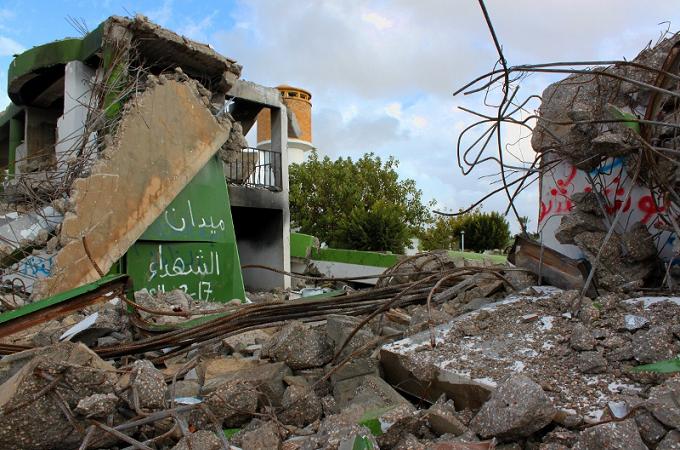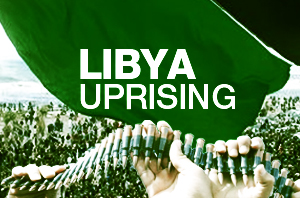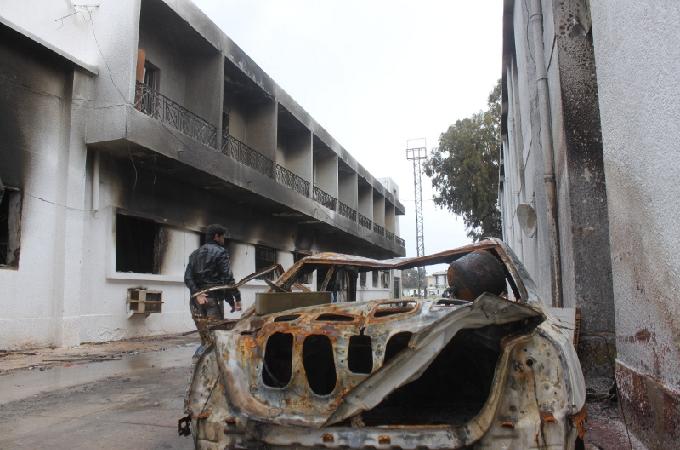The day the Katiba fell
Libya’s turning point may have come when protesters overwhelmed a barracks in Benghazi.

 Gaddafi’s forces lost control of the Katiba after three days of fierce clashes [Evan Hill/Al Jazeera]
Gaddafi’s forces lost control of the Katiba after three days of fierce clashes [Evan Hill/Al Jazeera]Benghazi, Libya – If Benghazi, Libya’s second city, has become the symbolic heart of the revolution in this north African nation, then the battle to overwhelm the military garrison here was the revolt’s key turning point.
Over the course of three days, civilians opposed to the 42-year rule of Colonel Muammar Gaddafi managed to outlast and overpower a fortified base guarded by detachments of several Libyan military units, one of them the feared and reportedly highly trained Khamis Brigade – a special forces unit led by Gaddafi’s youngest son.
In the end, both anti-government protesters and Gaddafi loyalists lost hundreds and many more were wounded, and Gaddafi’s forces fled the city.
Benghazi fell completely into opposition hands and became the seat of the national coalition bent on ending the Gaddafi regime. The once-feared ramparts of Gaddafi’s security forces sit smoldering and crumbled, a site for tourists.
A sudden spark
Inside the destroyed walls of the Katiba – which means battalion or phalanx in Arabic, but is shorthand in Benghazi for the garrison – the roof of a grandstand overlooking a broad concrete parade ground droops low, its supporting columns cracked, its white and green walls – the standard colour of Gaddafi’s regime – stained black by fire.

A gaping hole in the northern wall of the compound, all twisted metal bars and jagged concrete blocks, marks the spot where protesters first managed to push through under a hail of gunfire. In white spray-paint, someone has written “Martyrs’ Square” in Arabic on an unhinged metal gate that hangs off the breach.
Though activists were preparing a “day of rage” for February 17 to follow successful uprisings in Tunisia and Egypt, protests actually began in Benghazi on February 15, when hundreds of citizens angry over the arrest of human rights lawyer Fathy Terbil took to the streets.
Terbil had been representing the families of thousands of inmates who were reportedly slaughtered by the regime at Abu Salim prison in Tripoli in 1996. The sudden demonstrations, which evolved into anti-Gaddafi protests, took some young, politically active Benghazi residents by surprise.
“We just got talking at school and amongst my peers and friends, and you were asked, ‘Are you gonna protest on the 17th,’ and people were scared and said, ‘If a lot of people come out, then I’ll come out,'” said Ahmed Sanalla, a 26-year-old UK resident who has spent the past four years studying medicine at Garyounis University in Benghazi.
“Once they hit the ground, we joined, and then everyone else came along.”
That first day, anti-Gaddafi protesters clashed with regime supporters on Jamal Abdel Nasser Street, a main thoroughfare that runs through the centre of town toward the Mediterranean Sea.
A rock-throwing battle erupted between the two sides. At one point, a teenage boy clamoured up a post bearing a portrait of Gaddafi and tore it down. The crowd reacted with joy.
Police responded with force. Officers swarmed into the area from the main security headquarters. Armoured trucks fired hot water cannons at the protesters.
“That pretty much kicked off the whole thing,” Sanalla said.
Dozens of deaths
On February 16, security forces kept a tight lid on Benghazi. But the next day, the designated “day of rage,” a crowd of thousands of people including lawyers and judges gathered in the square outside the city’s main courthouse at the water’s edge.
The rare display of public anger prompted a deadly response from local security forces, who had almost no experience of domestic crowd control. Foreign journalists had yet to reach Benghazi, but witnesses reported that police had quickly opened fire with live ammunition, killing at least six people.
Meanwhile, protests sprang up in the cities of Baida and Tobruk, to the east, and the day closed with at least 24 people dead, according to a Human Rights Watch estimate.
 Destroyed and melted vehicles littered the sprawling Katiba compound. [Evan Hill/Al Jazeera]
Destroyed and melted vehicles littered the sprawling Katiba compound. [Evan Hill/Al Jazeera]“The security forces’ vicious attacks on peaceful demonstrators lay bare the reality of Muammar Gaddafi’s brutality when faced with any internal dissent,” Sarah Leah Whitson, the group’s Middle East and North Africa director, said.
Gaddafi had apparently had enough. The following day, a Friday, armed men wearing now infamous yellow construction hard hats flooded into Benghazi’s streets.
Residents say the thugs were ferried into Benghazi’s local airport by Afriqiyah airlines from elsewhere in Libya, or from neighbouring countries to the south, such as Chad and Niger.
Though many Libyans descend from sub-Saharan ancestry, making darker skin tones and non-Arab facial features a fairly common sight on the streets, anti-regime protesters were quick to label their attackers “African mercenaries”.
After mid-day prayers, crowds began a funeral procession bound for a local cemetery to honour Thursday’s dead. They marched past the main security headquarters in a neighbourhood called Hawari. As they stood outside, chanting in protest, police opened fire from the roof and atop the walls.
Benghazi fell into chaos. Photographs and video posted on the Internet by residents shows the men in hard hats rampaging through the city’s streets, firing handguns into the air and breaking into homes as terrified onlookers scream in horror from their balconies.
Witnesses say the men travelled in unmarked civilian cars and ambulances and fired assault rifles indiscriminately from their windows.
Army troops stationed in the city made encouraging statements to thousands of protesters who remained camped outside the main courthouse, but security forces stormed the crowd in the predawn hours that night, firing tear gas.
Human Rights Watch was forced to update its death toll continually; citing sources in Benghazi’s hospitals, the organisation said that 35 people had been killed in the city on Friday alone, most by gunfire.
In a country of only six million people – and a city of roughly 750,000 – where families trace their roots to extensive tribal networks, deaths do not go unnoticed or unrequited.
“Once blood was spilled, that was it,” Sanalla said.
‘Let him die’
The tide began to turn for the anti-regime forces on Saturday. Despite an Internet shut down and heavy restrictions on mobile phone communications, protesters still managed to mass in Benghazi.
They focused their rage on whatever symbols of the regime they could lay their hands on. Courts, police stations, prisons and a museum honouring the Gaddafi-written founding text of modern Libya – the Green Book – were all torched, until only the Katiba and the security building in Hawari remained.
Standing on the roof of the destroyed security headquarters on Sunday, Mohammed al-Huni, a young protester, recalled the fight. Between the exterior and interior walls of the “muderiya,” or directorate, as the compound is called, the ground was still covered with scores of rocks – the protesters’ most common weapon.
Facing men armed with rifles, the youth threw stones, converging on the building from the north and west. They used homemade explosives to break through outer gates, but under heavy fire from what witnesses identified as 14.5mm anti-aircraft guns, they withdrew.
Residents described a “massacre”; doctors in Benghazi said children as young as eight had been killed, and grotesque images of bodies dismembered by high-calibre ammunition emerged from Benghazi hospitals.
Asim Mahmoud, a 23-year-old student in the Garyounis University college of literature, worked occasionally inside the muderiya taking fingerprints for security forces. On Sunday, perusing the wreckage of rooms once occupied by high-ranking officers, he recounted with al-Huni the day the protesters massed and tried to storm the building.
Mahmoud’s cousin had been shot during a confrontation at the Katiba, and he was infuriated by Gaddafi’s arrogant statements that described protesters as drug addicts and terrorists. On the Saturday of the first assault, he hid inside with other security employees.
The next day, he changed out of his uniform, slipped out a side door, and ran to join the opposition. Al-Huni and Mahmoud now serve together as members of a civilian team guarding the muderiya from looters or Gaddafi loyalists.
Crowds drew close to the Katiba walls and began to hurl stones. Soldiers inside responded with gunfire. The exchanges continued until the soldiers called a truce.
They called out to the protesters that they were on the people’s side, opened the gates and beckoned the men closer to negotiate. Tawfik Omran, a 30-year-old engineer who was filming the confrontation, said his comrades told him to stay behind as they went forward, so he could document what happened.
When the youth approached to within around six metres, the army opened fire again, mowing down the front line of protesters. The men around Omran surged forward, yelling “God is great!” Omran turned to hold back a man who was trying to run ahead. The man fell. Omran tried to pick him up by his coat. Then he noticed the blood pouring out; the man had been shot in the neck.
Omran was overwhelmed by advancing soldiers. He pointed to the man, saying he had been severely injured and needed to go to the hospital. The soldiers kicked the man. “Let him die,” they said, according to Omran. Then they dragged Omran inside the compound and threw him into an underground prison until he was a later saved by protesters.
The army switches sides
On Sunday, the anti-regime forces set out to finish the job. Though the day started quietly, protest crowds began to mass in the afternoon. They equipped themselves with “joulateena” – small, homemade bombs that residents traditionally toss into the sea and detonate to kill a dozen fish at a time.
Outside the Katiba, as dusk arrived, men driving commandeered bulldozers and trucks loaded with petrol attempted to ram the walls. Many were shot to death behind their drivers’ wheels, their vehicles slowing to a halt in the street. Volunteer ambulance drivers careened through the combat, picking up victims and taking them to nearby hospitals.
 In one room, tongue depressors, antiseptic liquid, medicine and bandaids littered the floor. [Evan Hill/Al Jazeera]
In one room, tongue depressors, antiseptic liquid, medicine and bandaids littered the floor. [Evan Hill/Al Jazeera]At some point in the evening, longtime Gaddafi regime loyalist and special forces commander Abdel Fattah Younes defected to the protesters’ side.
Troops from his unit, based on the outskirts of town, arrived at the opposite side of the Katiba armed with machine guns and driving trucks mounted with anti-aircraft guns. Two tanks under Younes’s command followed.
Younes’s was the highest-profile defection and the most immediately beneficial to the protesters, but government troops had been switching sides for days since the uprising began.
Zakaria Abdelrahman al-Jihani, 24, left his military post on February 15 to return to Benghazi, his hometown.
Standing guard inside a former regime prison in Benghazi on Friday guarding a stockpile of returned weapons, al-Jihani said he had joined the army in 2004 and become a member of the Thafeda Bashariya, a naval commando unit. Before the uprising, his unit was assigned to guard an important oil installation at Ras Lanuf, several hundred kilometers west of Benghazi, near the Gaddafi stronghold of Sirte.
As protests broke out, al-Jihani’s commanders granted him and others leave to return home.
“The only thing in my mind was getting a weapon,” he said. “People were fighting with stones. They started shooting them with anti-aircraft guns.”
Al-Jihani and around 70 others, including friends from his unit, visited a nearby base the Friday before the Katiba attack and found it empty; the soldiers there had already joined the people, he said. They took rocket-propelled grenade launchers, AK-47s and anti-aircraft guns.
On Sunday, armed protesters using strategies similar to their comrades at the Katiba overwhelmed the security headquarters in Hawari and began acquiring more weapons there. The attack on the Katiba intensified, and protesters began breaching its walls and torching the barracks near the exterior.
According to some protesters, Younis, a longtime Benghazi resident, granted safe passage out of the city to loyalist troops escaping the Katiba.
As anti-regime forces gained access to the interior of the base, they saw evidence of the troops’ divided loyalties. Elements of three units had been stationed there to quell the uprising: The Fadheel brigade, out of Sitre; the Khamis brigade, from Tripoli; and the Tariq brigade, which was based in the southern town of Sabha.
Some soldiers in the Fadheel brigade, Omran said, were from Benghazi or had familial connections there and refused to fire on the protesters. A dozen or more of them were shot to death by their fellow soldiers, he said. Protesters would later discover the severely burned bodies of soldiers inside the Katiba, their hands tied behind their backs.
On Sunday night, at around 9:30, the Katiba battle ended. Gaddafi loyalists and mercenaries had been killed or captured, or had melted into the countryside or fled back to Tripoli. Opposition forces had won battle to free Benghazi, now they would have to figure out how to govern.
Follow Evan Hill on Twitter: @evanchill